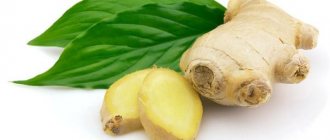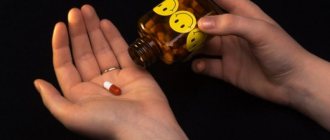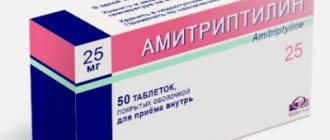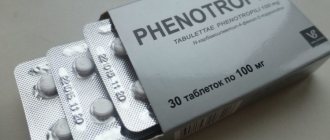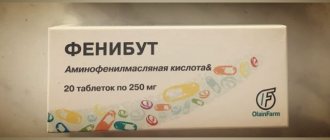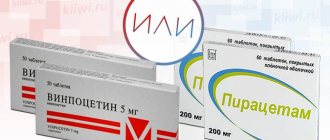| Check neutrality. There should be details on the talk page. |
| Check information. It is necessary to check the accuracy of the facts and reliability of the information presented in this article. There should be an explanation on the talk page. |
| This article or section needs revision. Please improve the article in accordance with the rules for writing articles. |
Nootropics
, they are also
neurometabolic stimulants
- drugs designed to provide a specific effect on higher mental functions. It is believed that nootropics can stimulate mental activity, activate cognitive functions, improve memory and increase learning ability. It is assumed that nootropics increase the brain's resistance to a variety of harmful influences, such as excessive exercise or hypoxia.
The term “nootropic” is derived from the Greek. νους - reason and τροπή - I turn, I interfere, I change. It was introduced in 1972 to describe the sensory-cognitive effects of piracetam. Later, similar effects were noticed in other substances or complexes of substances. In the English-language scientific literature they are often called smart drugs[1].
Story
| This section is missing references to information sources. Information must be verifiable, otherwise it may be questioned and deleted. You may edit this article to include links to authoritative sources. This mark was set on November 25, 2020 . |
In 1964, Belgian pharmacologists S. Giurgea and V. Skondia synthesized the first drug of this group - piracetam [2], now known mainly under the commercial name "nootropil". Like psychostimulants, it increased (in vivo) mental performance, but did not have the side effects inherent in psychostimulants.
In 1972, C. Giurgea coined the term nootropics.
[2] to designate a group of drugs that improve intellectual memory, attention, learning and have a characteristic stimulating effect on the evoked transcallosal potential, have additional antihypoxic activity and, unlike psychostimulants, do not have a negative effect on the body.
Unlike psychostimulants, stimulation of nerve cells with nootropics leads to increased activity and performance, which are not qualitative, but quantitative. The effect of most nootropics does not appear immediately after the first dose, as is observed with psychostimulants, but during long-term treatment.
Currently, more than 10 original nootropic drugs of the pyrrolidine series have been synthesized, which are in phase III clinical trials or have already been registered in a number of countries; among them are oxiracetam, aniracetam, etiracetam, pramiracetam, dupracetam, rolisiracetam, cebracetam, nefiracetam, isacetam, detiracetam. These nootropic drugs are collectively called racetams.
In addition, other families of nootropic drugs have been synthesized, including cholinergic, GABAergic, glutamatergic, and peptidergic. The nootropic component of action is also present in other classes of drugs that have different chemical origins.
Indications and restrictions for use
A dietary supplement is used in the presence of such symptoms as memory loss, deterioration in learning ability and concentration, and nervous tension. Nootropic is used for:
- improvement of the cognitive sphere;
- restoration of blood circulation in the brain and peripheral tissues;
- increasing mental activity;
- normalization of sleep;
- reducing intracranial pressure;
- improving mood and general emotional state;
- reducing the toxic effects of alcohol and other toxic substances.
This supplement is also recommended as an additional source of vitamins, glycine and flavonol glycosides.
The drug should not be used if there are some contraindications. Among them:
- individual intolerance to its constituent components;
- diabetes mellitus (for syrup);
- problems with the activity of the cardiovascular system (arrhythmia);
- blood pressure is too high;
- the presence of severe atherosclerosis;
- excessive nervous excitability;
- insomnia.
It is not recommended to use the Nootropic for pregnant women, women during lactation and children under 12 years of age. Its use may cause negative impacts on these population groups.
See also:
Instructions for use of the drug Noopept, indications, reviews from patients and doctors
Action
The therapeutic effect of nootropic drugs is based on several mechanisms:
- improvement of the energy state of neurons (increased ATP synthesis, antihypoxic and antioxidant effects);
- activation of plastic processes in the central nervous system due to increased synthesis of RNA and proteins;
- strengthening of synaptic transmission processes in the central nervous system;
- improved glucose utilization;
- membrane stabilizing effect.
Nowadays, the main mechanisms of action of nootropic drugs are considered to be the influence on metabolic and bioenergetic processes in the nerve cell and interaction with the neurotransmitter systems of the brain. It has been proven that nootropics activate adenylate cyclase and increase its concentration in the neuron. And the increased level of cyclic AMP (a cascade of intracellular reactions little studied today) leads through a change in the flow of intracellular K+ and Ca2+ ions to the accelerated release of the mediator (serotonin) from the sensory neuron. In addition, activated adenylate cyclase maintains the stability of ATP production in the cell without the participation of oxygen, and under hypoxic conditions it transfers brain metabolism to an optimally maintained mode. Correction of impaired intellectual function, primarily memory, with nootropics, activation of integrative functions of the brain is necessary, on the one hand, to increase the creative activity of a person in old age and old age, and on the other hand, to restore the mental retardation of children. Manufacturers of neurometabolic stimulants claim that their drugs penetrate the BBB well, increase the rate of glucose utilization (especially in the cerebral cortex, subcortical ganglia, hypothalamus and cerebellum), improve the metabolism of nucleic acids, and activate the synthesis of ATP, protein and RNA.
The effect of a number of nootropic drugs is possibly mediated through the neurotransmitter systems of the brain, among which the most important are:
- monoaminergic;
- cholinergic - phenotropil;
- glutamatergic (memantine and glycine act through NMDA receptors).
Nootropics, according to the companies that produce them, also have other effects, including [ source not specified 2348 days
]:
- membrane stabilizing: regulation of the synthesis of phospholipids and proteins in nerve cells, stabilization and normalization of the structure of cell membranes;
- antioxidant: inhibition of the formation of free radicals and lipid peroxidation of cell membranes;
- antihypoxic: reducing the oxygen demand of neurons under hypoxic conditions;
- neuroprotective: increasing the resistance of nerve cells to the effects of adverse factors of various kinds.
A significant role, according to manufacturers, is played by improving microcirculation in the brain by optimizing the passage of red blood cells through the microvasculature and inhibiting platelet aggregation.
Nootropic effects can be caused by something else.
The complex effect of nootropic drugs is said to improve the bioelectrical activity and integrative activity of the brain, which is manifested by characteristic changes in electrophysiological patterns (facilitation of the passage of information between the hemispheres, increased level of wakefulness, increased absolute and relative power of the EEG spectrum of the cortex and hippocampus, increase in the dominant peak).
The declared increase in cortico-subcortical control, improvement of information exchange in the brain, and a positive effect on the formation and reproduction of a memory trace allow pharmaceutical companies to claim that these “medicines” lead to improved memory, perception, attention, thinking, increased learning ability, and activation of intellectual functions. The claimed, but unconfirmed, ability to improve cognitive functions has given rise to calling nootropic drugs “cognitive stimulants.”
What kind of drugs are these?
Let's take a closer look at the means to improve brain activity. What are nootropics? The name of this group of medications comes from a combination of two words. The first of them is “noos”, which means “mind”, and the second is “tropos”, that is, “means”. To put it another way, these are substances that have an affinity (or, according to the medical term, “tropism”) for the mind. However, this is not entirely true. In this case, it is not worth identifying the mind as a whole. This is what “big psychiatry” does, which has in its arsenal antipsychotics that eliminate psychosis, tranquilizers that relieve anxiety, antidepressants, etc.
In this regard, it is necessary to more specifically understand the question “what are nootropics?” These are drugs that have some of the effects of neuropharmacological drugs used in psychiatry, but are less specific (which is why they are sometimes more useful). The fact is that psychiatry interferes with the most subtle processes of regulating brain activity. Sometimes this only harms the patient or creates drug dependence in him. Taking such medications can be compared to the effect of analgin on the body for symptoms of pain. This remedy will relieve unpleasant sensations, but it certainly will not remove their cause.
Nootropics work differently. They improve the activity of brain cells in general. And this, in turn, leads to the improvement of the human psyche. For example, insomnia, the cause of which lies in a chronic disorder of cerebral circulation or is a consequence of a head injury suffered by the patient, is sometimes eliminated over a long period with sleeping pills, such as Phenazepam, Sibazon, etc. But it is possible and even necessary to deal with brain treatment. To do this, you will need drugs that will improve blood circulation in the gray matter, enhance metabolic processes in nerve cells, protect membranes from destruction, and also eliminate aggressive molecules in the form of free radicals that harm its normal functioning. After this, insomnia, irritability, headache, weakness, dizziness, as well as other manifestations of astheno-vegetative disease will go away on their own. In this case, taking sedatives and sleeping pills will become only occasional.
Effects
In the spectrum of clinical activity of nootropics (neurometabolic stimulants) there are [ source not specified 3075 days
] the following claimed main effects:
- Nootropic effect (impact on impaired higher cortical functions, level of judgment and critical capabilities, improvement of cortical control of subcortical activity, thinking, attention, speech).
- Mnemotropic effect (effect on memory, learning ability).
- Increasing the level of wakefulness, clarity of consciousness (impact on the state of depressed and darkened consciousness).
- Adaptogenic effect (influence on tolerance to various exogenous factors, including medications, increasing the body’s overall resistance to extreme factors).
- Antiasthenic effect (effect on weakness, lethargy, exhaustion, phenomena of mental and physical asthenia).
- Psychostimulating effect (influence on apathy, hypobulia, aspontaneity, poverty of motives, mental inertia, psychomotor retardation).
- Antidepressant effect.
- Sedative (tranquilizing) effect, reducing irritability and emotional excitability.
- Autonomic effect (effect on headache, dizziness, cerebrasthenic syndrome).
- Antikinetic effect.
- Antiparkinsonian action.
- Antiepileptic effect, influence on epileptic paroxysmal activity.
- Hypoglycemic effect (reduce the concentration of glucose in the blood).
- It has an energetic effect (by increasing the consumption of glucose by the body's cells), which is why it is effective in sports at various stages of recovery after training.
- Somatotropin-stimulating effect (as a result of hypoglycemia, growth hormone is released).
- Anabolic effect (since they are amino acids, and anabolic and other hormones consist precisely of amino acid residues).
- Lipolytic (fat-mobilizing or fat-burning) effect (in conditions of lack of glucose, fatty acids begin to be released as energy).
- Antitoxic effect (by removing cell waste products from the body and neutralizing various harmful substances).
- Immunostimulating effect (see anabolic effect, leading to strengthening of the body).
Dosages and regimens for taking nootropics from the TOP-3
Nuances of use and dosage of popular nootropic drugs.
He was the first
The beneficial effects of Piracetam appear only after long-term use. Excretion from the body through the kidneys. Course 6-8 weeks at 1200-1400 mg/day.
Methods of administration:
- inside;
- intramuscularly;
- intravenously.
Release form:
- capsules;
- solution for intramuscular and intravenous administration;
- solution for oral administration;
- syrup;
- pills.
Fenotropil
After administration, Phenotropil is quickly absorbed by the body and penetrates into all tissues. Excretion from the body is carried out through the kidneys and liver.
Release form:
- tablets 50 mg;
- tablets 100 mg.
Release form: dropper bottle.
Classification
Nowadays, nootropics are classified according to their chemical composition.
- Pyrrolidone derivatives: piracetam, etiracetam, aniracetam, oxiracetam, pramiracetam, dupracetam, rolisiracetam, etc.
- Diaphenylpyrrolidone derivatives: phenotropil.
- Dimethylaminoethanol derivatives (precursors of acetylcholine): deanol aceglumate, meclofenoxate.
- Pyridoxine derivatives: pyritinol, biotredin.
- GABA derivatives and analogues: gamma-aminobutyric acid (aminalone), nicotinoyl-GABA (picamilon), gamma-amino-beta-phenylbutyric acid hydrochloride (phenibut), hopantenic acid, calcium gamma-hydroxybutyrate (sodium hydroxybutyrate).
- Neuropeptides and their analogs: noopept, Semax, Selank.
- Amino acids and substances affecting the system of excitatory amino acids: glycine, biotredin.
- 2-mercantobenzimidazole derivatives: ethylthiobenzimidazole hydrobromide (bemityl).
- Vitamin-like agents: idebenone.
- Polypeptides and organic composites: cortexin, cerebrolysin, cerebramin.
- Substances of other pharmacological groups with a nootropic component: neuromodulators: phenotropil;
- correctors of cerebral circulatory disorders: nicergoline, vinpocetine, xanthinol nicotinate, vincamine, naftidrofuryl, cinnarizine;
- general tonics and adaptogens: acetylaminosuccinic acid (known as “succinic acid”), ginseng extract, melatonin, lecithin.
- psychostimulants: sulbutiamine;
- antihypoxants and antioxidants: hydroxymethylethylpyridine succinate (Mexidol);
- acephen and its derivatives.
Signs of nootropic activity are present in the pharmacodynamics of glutamic acid, memantine and levocarnitine.
In addition, the experiment showed the nootropic effect of a number of neuropeptides and their synthetic analogues (ACTH and its fragments, somatostatin, vasopressin, oxytocin, thyrotropin-releasing hormone, melanostatin, cholecystokinin, neuropeptide Y, substance P, angiotensin II, cholecystokinin-8, peptide analogues of piracetam, etc. .).
Famous nootropics
| This section is missing references to information sources. Information must be verifiable, otherwise it may be questioned and deleted. You may edit this article to include links to authoritative sources. This mark was set on November 25, 2020 . |
- Ampakines
- pyrrolidone derivatives Piracetam (Nootropil)
- Aniracetam
- Oxiracetam
- Pramiracetam
- Fenotropil
- Picamilon
- Nicergoline, an ergoloid derivative
- Noopept
Approved by [ who?
] that other substances act similarly:
- Caffeine
- Nicotine
- Amphetamine (Phenamine, Adderall, Dexedrine)
- Adrafinil (Olmifon)
- Modafinil (Provigil)
- DMAE - used to treat attention disorder disorder. Has a geroprotective effect
- acetylcholinesterase inhibitors and acetylcholine precursors are two classes of drugs (supplements) that have a nootropic effect when used in limited doses: Choline alfoscerate [en] (Alpha-GPC, L-alpha glycerylphosphorylcholine, Choline alfoscerate) is the most effective choline precursor, freely crossing the blood-brain barrier;
- Huperzine A is a potent acetylcholinesterase inhibitor derived from Chinese clubmoss;
- CDP-Choline (Cytidine Diphosphate Choline) - a choline precursor, a more economical alternative to Alpha GPC
- Lecithin is a natural precursor of acetylcholine
WARNING: Large doses of acetylcholine may be hazardous to health.
Original domestic developments available in the pharmacy chain:
- Fenotropil
- Vinpotropil
- Adamantylbromophenylamine (Bromantane, Ladasten)
- Noopept
- Semax
- Selank
- Aminalon
Vitamins and vitamin-like substances with a pronounced nootropic effect:
- Acetyl-L-Carnitine[en] (ALCAR)
- Choline with Vitamin B5
- NADH
- Vitamin C
- coenzyme Q
- Sulbutiamine
Herbal raw materials with a nootropic effect:
- Ginkgo biloba - increases blood flow to the extremities and brain
- Withania Somnifera (Ashwagandha) - tonic that normalizes metabolic processes
- Bacopa monnieri - a sedative and tonic that supports electrochemical processes in the brain
- Melissa Officinalis (Lemon Balm)
- Eleutherococcus (Siberian ginseng) is a tonic and adaptogen that normalizes stress and increases mental abilities
- Celastrus paniculatus
- Gotu Kola
- Sutherlandia Frutescens
Amino acids and their derivatives:
- phenylalanine
- tyrosine
- glycine
- acetyl-aminosuccinic acid
Combined products containing several substances with nootropic activity. For example, piracetam with cinnarizine, piracetam with ginkgo biloba, ginkgo biloba with various combinations of herbs, piracetam with gamma-aminobutyric acid, piracetam with thiotriazoline, piracetam with diazepam, vinpocetine with piracetam, salbutiamine with NADH, etc. It is believed that combination drugs are more more effective than single drugs, since they allow you to influence several links in neuronal metabolism [ source not specified 2348 days
]. However, one should also remember about the possibility of potentiation of not only positive effects when using combination therapy, but also increased side effects. Although nootropics are considered perhaps the safest class of psychopharmacological drugs, they can nevertheless cause serious complications. For example, a potential risk that arises when taking cinnarizine is the development of drug-induced parkinsonism syndrome, especially in elderly patients [3].
Nootropics recommended by the editors of Organicnewsroom.com
Another site Organicnewsroom.com gives its list of recommended nootropics, in which it is easy to notice the names repeated above:
- Aniratam
- Oxiracetam
- Noopept
- Phenibut
- Vinpocetine
- Huperzine-A
- 5-HTP
- GABA
- Alpha GPC
- Choline
- L-Theanine
- Phenylethylamine (PEA)
- Lion's Mane (Yamabushitake)
- Bacopa
- Ginko Biloba
- Ashwaghanda
- Rhodiola
- N-Acetyl L-Tyrosine
From Zozhnik we will add that the reaction to various nootropics (as well as to many other things in this life) is very individual, experts on different sites recommend choosing what helps you. Also, you should not take many maintenance medications at once; try one thing at a time and monitor yourself carefully.
Sources: Wikipedia, Reddit, brainprotips.com, organicnewsroom.com
Clinical use of nootropics
Initially, nootropics were used primarily to treat brain dysfunction in elderly patients with organic brain syndrome. In recent years, mainly in third world countries, which may be due to the underdevelopment of government organizations regulating the registration and circulation of medicines, they have become widely used in various fields of medicine and surgery, including in geriatric, obstetric and pediatric practice, neurology, psychiatry and narcology.
Nootropic drugs are used in Russia for the following conditions:
- dementia of various origins (vascular, senile, Alzheimer's disease),
- chronic cerebrovascular insufficiency,
- psychoorganic syndrome,
- with the consequences of cerebrovascular accident, traumatic brain injury,
- intoxication,
- neuroinfections,
- intellectual-mnestic disorders (impaired memory, concentration, thinking), asthenic, asthenic-depressive and depressive syndrome,
- neurotic and neurosis-like disorder,
- vegetative-vascular dystonia,
- chronic alcoholism (encephalopathy, psychoorganic syndrome, abstinence),
- and also to improve mental performance.
Pediatric practice in developing countries (especially widespread in our country) has not escaped the fate of adult medicine. In pediatrics, justified (lack of amino acids, due to which normal protein biosynthesis in particular and metabolism in general does not occur) indications for prescribing nootropics are
- delayed mental and speech development,
- mental retardation,
- consequences of perinatal CNS damage,
- cerebral palsy,
- attention deficit disorder.
Some nootropics are used to correct neuroleptic syndrome (deanol aceglumate, pyritinol, pantogam, hopantenic acid), stuttering (phenibut, pantogam), hyperkinesis (phenibut, hopantenic acid, memantine), urinary disorders (nicotinoyl-GABA, pantogam), sleep disorders (glycine , phenibut, calcium gamma-hydroxybutyrate), migraines (nicotinoyl-GABA, pyritinol, Semax), dizziness (piracetam, phenibut, ginkgo biloba) for the prevention of motion sickness (phenibut, GABA). In ophthalmology (as part of complex therapy), nicotinoyl-GABA (open-angle glaucoma, vascular diseases of the retina and macula), ginkgo biloba (senile macular degeneration, diabetic retinopathy) are used.
Medicines for the treatment of the nervous system
This group of drugs includes substances for adults and children. They increase concentration, reduce fatigue during mental overload, calm the central nervous system, prevent panic attacks, improve sleep, and resistance to stress factors.
Our rating includes pharmaceuticals with proven effectiveness and a low level of toxicity (in the absence of overdoses). They do not cause side effects, but it is wiser to consult your doctor before taking them.
Glycine is an excellent sedative, maximum safety
The active component is aminoacetic acid. It is diluted with povidone and magnesium stearate. The main ingredient is a natural metabolite.
It regulates the metabolic processes of the central nervous system, slows down the activity of neurotransmitters, rarely causes allergic reactions, and is not addictive. The tablet must be dissolved.
Advantages:
- helps with intoxication;
- has an antioxidant effect;
- reduces aggressiveness;
- helps cope with physical and psycho-emotional fatigue;
- fights insomnia (calms, normalizes sleep);
- triples mental performance;
- reduces the consequences of alcohol poisoning;
- price;
- can be taken from birth;
- no contraindications;
- pleasant taste;
- brings instant relief;
- simple technique.
Glycine easily penetrates into any tissue and biological fluids, including the brain. With rapid absorption, it is quickly eliminated. Recommended during the rehabilitation period after traumatic brain injuries and strokes.
Flaws:
- unsightly packaging;
- Does not help with depression or severe stress.
Glycine is available without a prescription at any pharmacy. Customers appreciate him for this. The experts did not identify any deficiencies.
Aminalon - restoration of memory power, help with severe headaches
The active component gamma-aminobutyric acid is a central nervous system mediator. It takes part in central inhibition reactions, activates brain functions, normalizes its processing of glucose, and helps normalize the respiratory activity of all tissues.
The result of Aminalon's action is the restoration of normal blood circulation in the brain and improvement of the dynamics of nervous processes. Tests of the substance have shown its usefulness in restoring speech, motor skills, and movements in patients with cerebral circulation problems.
Advantages:
- improves memory;
- effect on the body after taking 1 tablet;
- simple technique;
- no discomfort when taking;
- stabilizes blood pressure;
- eliminates sleep disorders;
- helps with severe, frequent headaches;
- price;
- slight calming effect;
- spectrum of action.
Gamma-aminobutyric acid can act as an auxiliary drug in the treatment of seizures and insomnia. It enhances the effects of anticonvulsants and hypnotics.
Flaws:
- nausea after 2-3 days of use;
- jumps in body temperature;
- individual intolerance to components;
- insomnia;
- dyspnea.
Aminalon is not recommended for children under 5-7 years of age or for pregnant women. Persons with hypersensitivity should also not use the substance. If adverse reactions occur, it means that it is better to take less aggressive pharmaceuticals. Before taking, be sure to consult with your doctor.
Piracetam - improves brain function, reduces conflict and irritability
The active component is a derivative of gamma-aminobutyric acid. The formula of the pharmaceutical substance contains a considerable auxiliary composition. Thanks to them, nootropil is quickly absorbed from the digestive tract (30-40 minutes) and reaches maximum concentration.
Doctors note an improvement in cognitive function after taking 2 tablets. But the absorption of Piracet by brain cells is slower - 2.3-4.5 hours.
Advantages:
- increases performance and learning ability;
- has a calming effect on the central nervous system;
- affects synaptic conduction;
- helps with intoxication;
- normalizes sleep;
- has a minimal list of side effects;
- price;
- increases stress resistance;
- relieves tinnitus, migraines;
- relieves apathy and depression;
- simple technique.
Piracetam is the first and most studied nootropil. Experts point to an increase in metabolic functions in nerve cells when taking the drug, and an improvement in blood microcirculation. The substance does not have a vasodilating effect, but has a protective effect on brain cells.
Flaws:
- stomach pain;
- the appearance of dizziness;
- allergy to the components of the drug;
- a competent approach is needed.
Experts insist that you consult a doctor before purchasing Piracetam. The medicine requires strict administration control.
Calcium hopantenate - help with psycho-emotional overload, decreased performance
The active substance is hopantenic acid. It improves the brain's resistance to the effects of toxins and hypoxia. Experts point to the high anticonvulsant quality of the drug, and customers like the ease of administration.
The tablets do not cause discomfort when swallowed, and there is no need to comply with specific conditions for taking them. Doctors observe a surge in physical and mental activity in patients and recommend Calcium hopantenate for alcoholic intoxication.
Advantages:
- reduces anxiety;
- helps in stressful situations, emotional stress;
- has a positive effect on sleep quality;
- saves in case of poisoning;
- helps fight childhood hyperactivity;
- mild sedative effect;
- reduces motor excitability;
- helps to concentrate attention;
- prolongs the duration of action of painkillers;
- improves brain function.
Calcium hopanthenate helps with pathologies of cognitive functions and epilepsy. Doctors recommend it for children aged 3 years and older when diagnosing urinary disorders. Hopanthenic acid alleviates the situation with enuresis and urinary incontinence.
Flaws:
- skin rashes;
- allergies, rhinitis;
- conjunctivitis;
- increases excitability.
Doctors focus on proper selection of the dosage of Calcium hopanthenate. If the treatment is chosen incorrectly, the remedy gives the opposite result. There are no other shortcomings.
Nootropic - increased activity, improved well-being and brain function
Buyers consider the pharmaceutical product to be the best in the price-quality and composition category. The active ingredient of the Nootropic is glycine. It is safe, quickly eliminated from the body, and its effectiveness has been proven by doctors. Important auxiliary components are B vitamins, vitamin K1, ginkgo biloba and gotu kola extracts.
Experts note the beneficial effects of Nootropic on the body as a whole. It increases physical endurance and activity. Helps to calm down, stabilizes the functioning of the central nervous system, increases resistance to stress.
Advantages:
- increases immunity;
- excellent sedative;
- help with insomnia;
- increases brain performance;
- improves memory;
- saves you from illnesses in the off-season;
- increases the body's endurance and resistance to stress;
- helps not to be nervous, copes with depression;
- safe;
- excellent composition;
- An excellent addition for nutritional problems in children.
Experts classify Nootropics as biological supplements. It is believed that this is the best drug for treating depression, apathetic states, and high morbidity. It is recommended to take the pharmaceutical drug during excessive physical and psycho-emotional stress.
Flaws:
- no treatment results (1.2% of buyers);
- price.
Experts remind that a noticeable effect of the drug can be obtained only if there are cognitive impairments or problems of the central nervous system.
Semax - harmlessness, immediate improvement in brain function
This is a new generation drug with an antioxidant effect. It stimulates processes that enhance memory formation, concentration, and learning ability.
Analysis of the composition showed the effectiveness of the pharmaceutical substance in restoring the functioning of brain cells. It instantly reduces psycho-emotional fatigue and helps to adapt.
Experts like its non-toxic composition and method of administration. Buyers note the effective effect of Semax on problems with children's learning and perseverance. But there are disadvantages - price, increased excitability.
Evidence of effectiveness
| This section is missing references to information sources. Information must be verifiable, otherwise it may be questioned and deleted. You may edit this article to include links to authoritative sources. This mark was set on November 25, 2020 . |
Nootropic drugs do not have indications for use approved by the US Food and Drug Administration due to the lack of objective evidence of their effectiveness (with the exception of cortical myoclonic epilepsy).
The following is a brief excerpt about the available evidence of the effectiveness of some drugs from this group, published on the basis of the text of a manual on pharmacotherapy for doctors and surgeons, Medicines, prepared by the Ministry of Health of the Russian Federation from the standpoint of evidence-based medicine, and published by GEOTAR-Media.
Vinpocetine (international name: Vinpocetinum; commercial names by which the drug is known in our country: Vinpocetine, Cavinton). Summary and additional information:
- Not represented in the US Pharmacopoeia.
- 27 clinical trials since 1985
Note: All listed indications for the use of the drug have a degree of evidence* not higher than “C” (mostly “D”).
Hopantenic acid (international name: Acidum hopantenicum; commercial names under which the drug is known in our country: Gopantam, Calcium hopantenate, Pantogam, Pantocalcin). Summary and additional information:
- There is no evidence of effectiveness and safety in the Cochrane database or other sources of evidence-based information.
- Not represented in the US Pharmacopoeia.
- 1 clinical trial since 1988
Note: None of the listed indications for use have a level of evidence*.
Nicotinoyl gamma-aminobutyric acid (international name: Acidum nocotiniyl-gamma-aminobutyricum; commercial names by which the drug is known in our country: Picamilon). Summary and additional information:
- Not represented in the US Pharmacopoeia.
- There are no clinical trials in the Cochrane Library** databases.
Note: None of the listed indications for use have a level of evidence*.
Piracetam (international name: Piracetamum; commercial names by which the drug is known in our country: Piracetam, Lucetam, Nootropil). Summary and additional information:
- Systematic reviews of available clinical trials to date have not confirmed the effectiveness of piracetam. Further research is needed.
- Not represented in the US Pharmacopeia.
- 333 clinical trials since 1972
Phenibut (international name: Phenybutum; commercial names by which the drug is known in our country: Phenibut). Summary and additional information:
- Not represented in the UK and US pharmacopoeias.
- 2 clinical trials since 1997
Note: None of the listed indications for use have a level of evidence*.
Phenotropil (International patented names: Phenotropil, Phenotropil, Phenotropilum). INN: (4RS)-phenyloxopyrrolidinylacetamide, (4RS)-phenyloxopyrrolidinylacetamide, (4RS)-phenyloxopyrrolidinylacetamidum). Summary and additional information:
- The patented medicine, substance and finished dosage forms are produced in Russia.
- Not represented in the US Pharmacopeia
- Clinical trials not registered in the Cochrane Database**.
Note: The degree of evidence for use is the results of preclinical and clinical studies.
Cerebrolysin (international name: Cerebrolysinum; commercial names by which the drug is known in our country: Cerebrolysin). Summary and additional information:
- There is currently no evidence of effectiveness for most indications.
- Not represented in the US Pharmacopoeia or ATC classification.
- 53 clinical trials since 1976
Cinnarizine (international name: Cinnarizinum; commercial names by which the drug is known in our country: Cinnarizine; Stugeron). Summary and additional information:
- Not represented in the US Pharmacopoeia.
- 137 clinical trials since 1966
Ethylmethylhydroxypyridine succinate (international name: (A)ethylmethylhydroxypyridini succinas; commercial names by which the drug is known in our country: Mexidant, Mexidol, Mexicor). Summary and additional information:
- Not represented in the US Pharmacopoeia.
- There is no convincing evidence confirming the clinical effectiveness of the drug.
- Clinical trials not registered in the Cochrane Database**.
Explanations:
- *There are 4 (sometimes said to be 5) levels, or grades, of evidence: from A (“gold standard” - this means high confidence in claims of effectiveness for the indications indicated for a given drug/intervention) to D(E) - the statement is based on expert opinion; There are no clinical studies.
- **The Cochrane Library, or database, is a regularly published, independent summary of data on the effectiveness in medicine and surgery of a particular intervention or drug.
Literature
- Akhapkina V.I., Voronina T.A. Spectrum of pharmacological effects of Phenotropil. // Pharmateka, 2005.
- Avedisova A.S., Yastrebov D.V. Comparative effectiveness of Noopept and Piracetam in the treatment of asthenic disorders and disorders of organic genesis. // Russian Medical Journal, 2007, No. 5.
- Korotkov S.A. Experimental study of the pharmacokinetics and biotransformation of the new dipeptide nootropic noopepat. Author's abstract. dis. for the job application scientist step. Ph.D. biol. Sci. Moscow, 2003.
- Neznamov G.G., Teleshova E.S., Syunyakov S.A., Bochkarev V.K., Davydova I.A. Results of a clinical study of the new peptide drug Noopept in patients with psychoorganic disorders. // Psychiatry and psychopharmacotherapy, 2007, vol.9, no.2.
- ANTIPSYCHOTICS: Features of undesirable side reactions in elderly and senile people. Ostroumova O.D., Goloborodova I.V., Isaev R.I., Pereverzev A.P. Journal of Neurology and Psychiatry. CC Korsakov. 2020.
Lyudmila Zhavoronkova
Higher medical education. 30 years of working experience in practical medicine.
More about the author
Last updated: October 31, 2019

